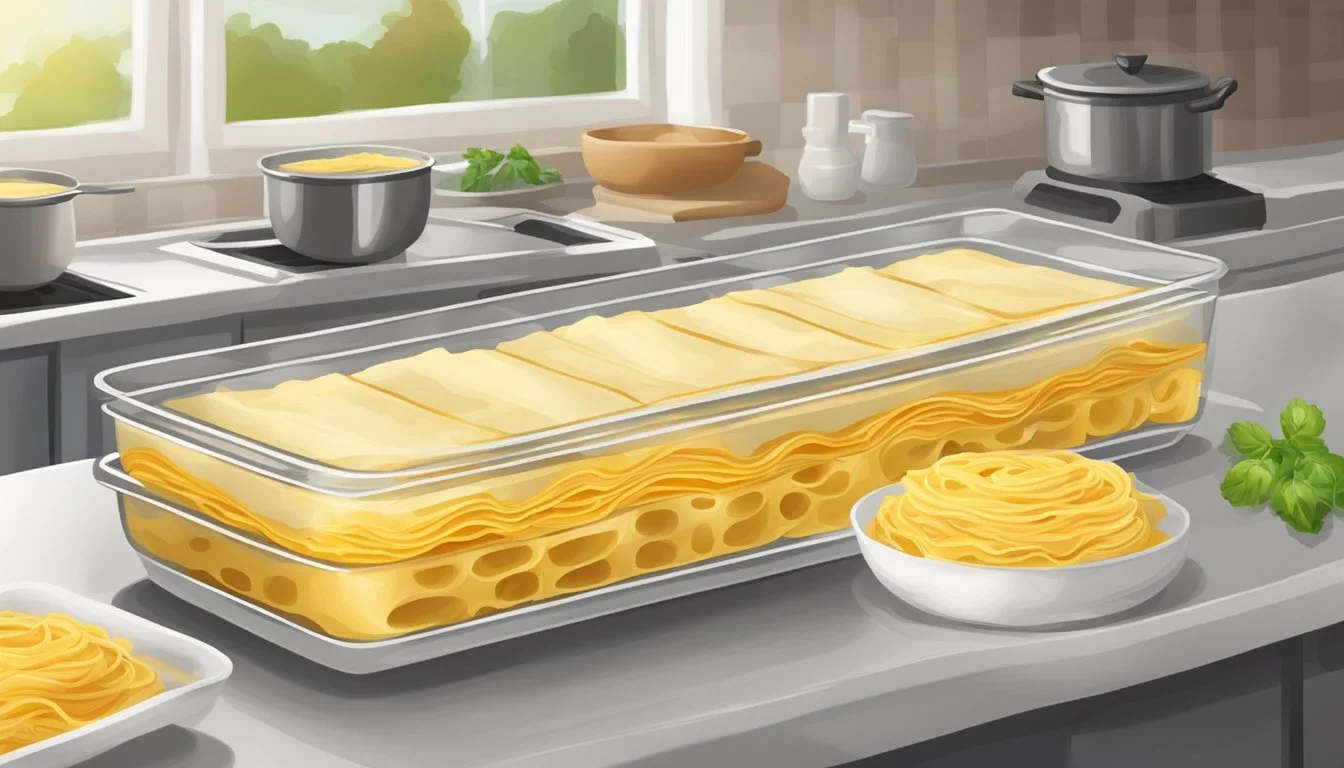How Long Does Cheese Lasagna Last?
Storage Tips and Shelf Life
Cheese lasagna is a beloved dish that can bring comfort to any meal, but it's essential to know how long it lasts to ensure safety and quality. Properly stored cheese lasagna can last for 3 to 5 days in the refrigerator. This time frame is crucial to maintain its taste and prevent any foodborne illnesses.
To maximize the shelf life of cheese lasagna, it should be stored in airtight containers or wrapped tightly with plastic wrap or aluminum foil. This method helps maintain its freshness by preventing moisture loss and contamination.
For those looking to keep their lasagna for an extended period, freezing is an excellent option. Cheese lasagna can be frozen for up to 6-8 months. Make sure to use covered airtight containers or heavy-duty freezer bags to preserve its quality.
Understanding Cheese Lasagna Shelf Life
Cheese lasagna can be enjoyed for several days when stored correctly. Key factors influencing its shelf life include storage conditions, ingredients, and spoilage prevention methods.
Factors Affecting Lasagna Shelf Life
Proper storage is essential. Cooked cheese lasagna should be stored in an airtight container or wrapped tightly with plastic wrap to prevent exposure to moisture and air.
Temperature plays a crucial role as well. Storing lasagna at the coldest part of the refrigerator, typically the bottom shelf, helps maintain its quality.
Ingredients such as ricotta and mozzarella have different shelf lives, impacting the overall freshness. Homemade lasagna usually lasts for 3 to 5 days in the refrigerator, while store-bought versions might have preservatives extending their shelf life to 5 to 7 days.
Identifying Spoilage Signs in Lasagna
Detecting spoilage is vital to avoid foodborne illnesses. Mold is one of the most apparent signs. Visible mold growth on the surface indicates that the lasagna should be discarded immediately.
An off smell is another indicator. If the lasagna emits a sour or unusual odor, it’s best not to consume it.
Texture changes also signal spoilage. A slimy or excessively dry texture suggests the lasagna may no longer be safe to eat.
Lastly, discoloration such as darkened or faded areas, particularly on the cheese, should be regarded with caution.
Recognizing these signs can ensure that the lasagna remains safe and enjoyable to eat.
Optimal Storage Conditions for Lasagna
Proper storage is key to extending the shelf life of cheese lasagna. Whether keeping it in the refrigerator or the freezer, it’s important to follow specific practices to maintain freshness and prevent spoilage.
Refrigerator Storage Practices
Lasagna can be safely stored in the refrigerator for up to five days when kept at a temperature below 40°F (4°C). Use airtight containers or wrap tightly with plastic wrap or aluminum foil to prevent exposure to air and moisture. Cool the lasagna at room temperature for about 30 minutes before refrigerating to avoid condensation. Place it on a shelf rather than in the door to maintain a consistent temperature.
Freezer Storage Solutions
For longer storage, lasagna can be frozen for up to three months. Use freezer-safe containers or durable aluminum foil before placing in the freezer. To prevent freezer burn, wrap the lasagna tightly and ensure there are no gaps. It’s beneficial to label the container with the date of freezing. Set the freezer temperature to 0°F (-18°C) to ensure the lasagna remains safe for consumption and preserves its quality.
Safety and Health Considerations
Cheese lasagna can be a delicious and satisfying dish, but it is crucial to handle and store it correctly to prevent foodborne illnesses. Below, find specific tips on maintaining safety and health.
Preventing Foodborne Illness
To prevent foodborne illness, it is essential to store cheese lasagna properly. Refrigerate cooked lasagna within two hours of cooking. Use airtight containers or wrap it in aluminum foil or plastic wrap to avoid bacterial growth.
Keep lasagna at an internal temperature of 40°F (4°C) or below while in the refrigerator. Reheating should be done to an internal temperature of 165°F (74°C) to kill any potential bacteria.
Avoid leaving lasagna at room temperature for more than two hours. If the temperature is above 90°F (32°C), the safe window reduces to one hour. Rapid bacterial growth can occur, increasing the risk of foodborne illness.
Preserving Cheese Lasagna's Quality
Maintaining the quality, texture, and flavor of cheese lasagna involves specific storage techniques and understanding how freezing impacts the dish. Focus is on airtight packaging and the freezing process to maximize shelf life and taste.
Airtight Packaging Techniques
Using an airtight container is crucial for preserving cheese lasagna. It prevents moisture from entering or escaping, which helps maintain the texture and flavor.
After cooking, let the lasagna cool to room temperature to avoid condensation. Place it in a container with a tight seal or wrap it tightly with plastic wrap and aluminum foil. For added protection, use both methods together.
Labeling the container with the date can help track freshness. Proper storage slows down bacterial growth, ensuring the lasagna can be refrigerated for up to five days.
Impact of Freezing on Texture and Flavor
Freezing cheese lasagna extends its shelf life but can alter its texture and flavor. To minimize changes, cool the lasagna before freezing and avoid frequent temperature fluctuations.
Wrap it securely in plastic wrap, then in aluminum foil, or use a vacuum-sealed airtight container. This keeps it fresh for up to three months.
When thawing, move the lasagna to the refrigerator 24 hours before reheating. Reheat slowly, either in an oven at 350°F (177°C) or a microwave, to retain as much of the original quality as possible.
Proper Thawing and Reheating Methods
Lasagna can be eaten at its best when properly thawed and reheated. Here are detailed methods to handle both processes effectively.
Thawing Frozen Lasagna
To thaw frozen lasagna, place it in the refrigerator overnight. This slow thawing method helps maintain its texture. Avoid leaving it on the counter, as it increases the risk of bacterial growth.
Another faster option is defrosting in the microwave. Place the lasagna in a microwave-safe dish, cover it, and select the defrost setting. Heat in short intervals, checking every few minutes.
Lastly, you can thaw it in a cold water bath, changing the water every 30 minutes. Ensure the lasagna is in an airtight container or a sealed plastic bag.
Reheating Techniques for Best Quality
For reheating lasagna, use an oven or stovetop for ideal results. Preheat the oven to 350°F, then cover the lasagna with aluminum foil to retain moisture. Bake for 20-30 minutes until it reaches an internal temperature of 165°F.
Using the stovetop, place the lasagna in a skillet with a small amount of water. Cover and heat on medium-low for about 20 minutes, shaking occasionally.
The microwave can also be used. Place the lasagna in a microwave-safe dish, cover with a microwave-safe lid or wrap, and heat on medium power for 5-7 minutes per serving, checking halfway.
These methods ensure the lasagna is heated thoroughly and retains its delicious taste and texture.
Handling Leftover Cheese Lasagna
Properly handling leftover cheese lasagna ensures food safety and maintains the quality of the dish. Key points revolve around appropriate storage techniques and best practices for dealing with partially consumed portions.
Storing and Accessing Leftovers
Refrigerate leftover cheese lasagna promptly to prevent spoilage. Cut the lasagna into individual portions and place them into airtight containers or wrap tightly with plastic wrap. Store in the refrigerator for up to 3-5 days.
Allow the lasagna to cool at room temperature before refrigerating to avoid condensation. Label containers with the date to keep track of storage time.
To reheat, use the oven or microwave. Preheat the oven to 350°F (177°C) and bake for 15-20 minutes. For the microwave, heat individual portions on high for 3-5 minutes until the internal temperature reaches 165°F (74°C).
Dealing with Partially Consumed Lasagna
If only part of the lasagna was consumed, leaving the rest in the baking dish can increase the chance of contamination. Cut consumed sections away and transfer remaining lasagna to a new airtight container.
Ensure areas previously cut are covered well to prevent them from drying out. Use a fresh piece of plastic wrap or foil to wrap the baking dish tightly before storing.
Be vigilant about signs of spoilage, such as an off smell, mold, or unusual texture. When in doubt, it is safer to discard the leftover lasagna than risk consuming spoiled food.
Maximizing the Lifespan of Lasagna
To ensure your lasagna stays fresh as long as possible, it's essential to store it correctly and take preventive measures against spoilage. The following strategies can help you get the most out of your lasagna, whether you’re storing it in the fridge or freezer.
Freezing and Refreezing Strategies
Freezing lasagna can extend its lifespan significantly. When freezing, make sure to use airtight containers or heavy-duty aluminum foil to prevent freezer burn. Labeling your containers with dates helps track how long the lasagna has been frozen.
Thawed lasagna should not be refrozen unless it was thawed in the refrigerator. Refreezing at room temperature can increase the risk of spoilage and bacteria growth. Quick freezing immediately after preparation maximizes freshness. For best results, consume frozen lasagna within 2-3 months.
Preventive Measures Against Spoilage
Properly cooling lasagna before refrigeration is crucial. Let it cool at room temperature for about 30 minutes. This minimizes condensation and prevents sogginess. Storing lasagna in shallow, airtight containers can also reduce spoilage.
Avoid cross-contamination by keeping lasagna separate from raw foods. Reheat leftovers to an internal temperature of 165°F (74°C) to eliminate bacteria. Consume refrigerated lasagna within 3-5 days to ensure safety. High-protein and dairy components make lasagna prone to spoilage, so following these measures is essential.
By implementing these freezing and spoilage prevention techniques, lasagna can be enjoyed safely for extended periods.
Cheese Lasagna Cooking and Preparation Tips
Perfecting cheese lasagna begins with choosing the right ingredients and using proper cooking techniques. These practices help extend the dish's longevity and enhance its flavors.
Selecting Ingredients for Freshness and Longevity
When preparing cheese lasagna, the freshness of ingredients is crucial. Ricotta cheese should be sourced as fresh as possible, ideally from a reputable deli or fresh dairy section. Look for mozzarella and parmesan cheese that are well within their use-by dates. Fresh pasta is preferred but dried pasta can also be used. Always choose high-quality sauce; homemade sauces with fresh tomatoes and herbs can elevate the dish and help maintain its freshness.
Use fresh vegetables like spinach or bell peppers for added nutrients and flavor. If using meat, ensure it is fresh and properly cooked before assembling the lasagna. These steps significantly influence the dish’s shelf life by reducing the risk of spoilage from poorly selected or stale ingredients.
Proper Cooking Methods to Extend Shelf Life
Preheat your oven to a consistent temperature, generally around 375°F (190°C) for traditional cheese lasagna. Use a light layer of olive oil or non-stick spray on the baking dish to prevent sticking. Layering the lasagna properly can also impact its shelf life. Start with a base layer of sauce to prevent the pasta from drying out and ensure even moisture distribution.
Cover the dish with aluminum foil during the initial phases of baking. This helps in cooking the lasagna evenly without scorching the top. Removing the foil in the last 10 minutes allows the cheese to brown nicely. After baking, let the lasagna cool to room temperature before storing it in the refrigerator. Proper storage in an airtight container can extend its freshness for several days.









